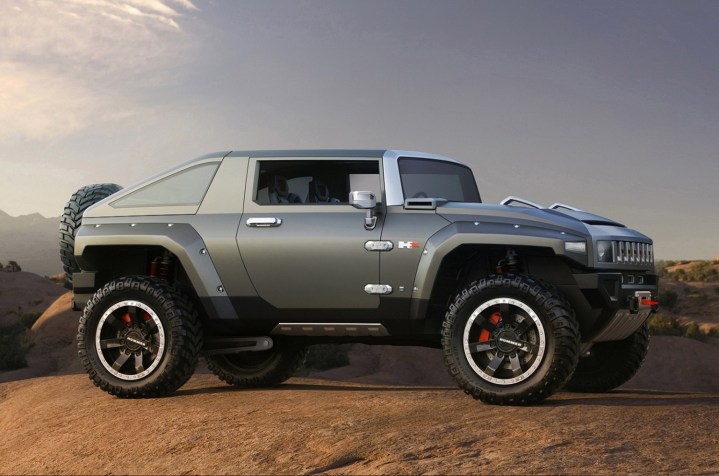
Once the vilified poster child of fuel inefficiency, the Hummer brand could make an unexpected comeback with an unabashed focus on zero-emissions off-road prowess. The about-face risks alienating some die-hard Hummer fans, but it will lure new enthusiasts into the fold while ensuring parent company General Motors keeps up with a growing list of rivals in a burgeoning segment of the market.
The idea of relaunching Hummer is gaining traction inside GM’s glass-walled Renaissance Center headquarters, Bloomberg learned from inside sources who asked to remain anonymous. Following the path blazed by Michigan-based startup Rivian, the born-again brand would offer consumers a lineup of battery-electric off-roaders that would be as capable as they are green. You can call it redemption or common sense; either way, the new Hummer would operate according to a completely different mind-set than the old Hummer.
GM axed Hummer in 2010 as it navigated bankruptcy, and as consumers were beginning to take fuel economy very seriously in the wake of skyrocketing gas prices. Selling a big, fuel-slurping SUV with an in-your-face design like the H1 became nearly impossible. At the time of its untimely retirement, Hummer was allegedly on the cusp of releasing a fourth model tentatively called H4 that was aimed squarely at the Jeep Wrangler. It’s too early to tell whether this relatively small SUV, which was previewed by the 2008 HX concept (pictured above), will once again appear on its product timeline if hummer comes back to life because the project remains at the embryonic stage.
Bloomberg stressed that GM executives haven’t approved the plan to resurrect Hummer yet; it’s merely one of many options they’re evaluating. If it rises from the dead, Hummer’s newfound focus on electric mobility risks isolating the faction of its old clientele that purchased mammoth-sized SUVs like the H1 and the H2 solely to brag about the unusually large size of their carbon footprint. They weren’t the ones keeping the brand alive, though, and bringing new customers into showrooms could easily offset their loss.
Above all, a Hummer must be extremely capable off-road. The brand traces its roots back to the American military, and it proved its mettle in some of the world’s most hostile regions during the 1990s. GM needs to keep this heritage in mind; releasing a watered-down, curb-hopping crossover would be a sure way to ensure the brand’s relaunch is a fiasco. Luckily, electrification and off-road prowess aren’t mutually exclusive.
Electric motors deliver instant torque, which is a boon when crawling over obstacles like logs and rocks. The bulky battery pack that feeds them keeps the center of gravity low, which reduces the risk of a rollover. It also doubles as a mobile power supply, so adventure-minded motorists can venture off the grid and still have an outlet to charge their phone or plug in their guitar amp. Finally, by using two (or more) motors, it’s far easier to control how much torque gets channeled to each axle, and even each wheel.
Credibly bringing Hummer back as an EV-only brand is doable, and Rivian proved the market is there. The R1T and R1S concepts it unveiled during the 2018 Los Angeles Auto Show received a tremendous amount of positive attention, even though the company admitted early on that both models will start in the vicinity of $70,000 — that’s nearly twice what the average buyer spends on a new car. Whether it can convert headlines into sales remains to be seen, but its business plan looks promising enough to move giants like GM to action.
In an odd twist of fate, Hummer’s born-again models could have shared their basic architecture and some of their mechanical components with Rivian’s aforementioned concepts. Rivian is eager to share its so-called skateboard platform with other automakers, likely to offset the cost of developing it. The tie-up talks with GM collapsed in April 2019, and Amazon-funded Rivian announced a partnership with Ford a few days later.
Hummer could be GM’s revenge against Rivian. If there’s one thing the brand is good at, it’s war.



